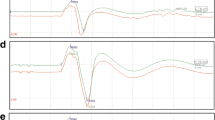We investigated whether epidural magnesium sulfate administration can produce motor blockade and/or sensory blockade in rabbits. Control animals (group C) received 1.2 ml isotonic saline, group M received 1 ml 15% (150 mg) magnesium sulfate and 0.2 ml isotonic saline (to flush the catheter), while group L received 1 ml 1% lignocaine and 0.2 ml isotonic saline. On the 1st day, somatosensory evoked potentials (SEPs) were recorded; on the 2nd day, motor blockade was evaluated, and the heart rate, mean arterial pressure (MAP), serum PaCO2, and serum magnesium level were measured. Compared with groups C and M, the MAP in group L was significantly reduced at the 2nd–5th, 15th, and 30th min. Significant motor blockade was found only in group L. No significant difference was found in a comparison of the latencies and amplitudes of SEP waves P and N between groups. Comparisons within the groups showed that the P1 wave latency in group C significantly increased at the 15th min, while the latency of wave N1 showed a significant decrease at the 60th min in group M. The latencies of the N1 and P1 waves showed significant increases at the 5th min in group L. Thus, our study showes that epidural administration of 150 mg magnesium sulfate in rabbits produces no motor or sensory blockade.
Similar content being viewed by others
References
L. Dube and J.C. Granry, “The therapeutic use of magnesium in anesthesiology, intensive care and emergency medicine: a review,” Can. J. Anaesth., 50, 732–746 (2003).
M. Bahar, M. Chanimov, E. Grinspun, et al., “Spinal anaesthesia induced by intrathecal magnesium sulphate,” Anaesthesia, 51, 627–633 (1996).
M. Bahar, M. L. Cohen, Y. Grinspun, et al., “Serum electrolyte and blood gas changes after intrathecal and intravenous bolus injections of magnesium sulphate,” Anaesthesia, 52, 1065–1069 (1997).
M. Chanimov, M. L. Cohen, Y. Grinspun, et al., “Neurotoxicity after spinal anaesthesia induced by serial intrathecal injections of magnesium sulphate,” Anaesthesia, 52, 223–228 (1997).
D. A. Raw, J. K. Beattie, and J. M. Hunter, “Anaesthesia for spinal surgery in adults,” Br. J. Anaesth., 91, 886–904 (2003).
S. Karasawa, K. Ishizaki, and K. Goto, “The effect of intrathecal administration of magnesium sulphate in rats,” Anaesthesia, 53, 879–886 (1998).
A. Dror and E. Henriksen, “Accidental epidural magnesium sulphate injection,” Anesth. Analg., 66, 1020–1021 (1987).
E. J. Goodman, A. J. Haas, and G. S. Kantor, “Inadvertent administration of magnesium sulfate through the epidural catheter: report and analysis of a drug error,” Int. J. Obstet. Anesth., 15, 63–67 (2006).
K. Murao, K. Shingu, K. Tsushima, et al., “The anticonvulsant effects of volatile anesthetics on lidocaine-induced seizures in cats,” Anesth. Analg., 90, 148–155 (2000).
A. Arkan, S. Küçükgüçlü, A. Küpelioglu, et al., “New technique for catheterization of the sacral canal in rabbits,” Contemp. Top. Lab. Anim. Sci., 35, No. 5, 96–98 (1996).
J. M. Malinovsky, J. M. Bernard, M. Baudrimont, et al., “A chronic model for experimental investigation of epidural anesthesia in the rabbit,” Reg. Anesth., 22, No. 1, 80–85 (1997).
S. Ciçek, A. Attar, H. Tuna, et al., “Effects of different doses of epidural midazolam on spinal somatosensory evoked potentials,” Acta Neurochir. (Wien), 142, No. 8, 921–927 (2000).
B. L. Loughnan, P. S. Sebel, D. Thomas, and H. Rogers, “Evoked potentials following diazepam or fentanyl,” Anaesthesia, 42, 191–198 (1987).
T. Akutagawa, L. M. Kitahata, H. Saito, et al., “Magnesium enhances local anesthetic nerve block of frog sciatic nerve,” Anesth. Analg., 63, 111–116 (1984).
A. W. Owczarek, J. Owczarek, A. Obolewska, and D. O. Michalak, “Effect of propranolol and midazolam therapy on hemodynamic parameters in rabbits,” Med. Sci. Monit., 6, 896–900 (2000).
T. B. Sloan, M. L. Fugina, and J. R. Toleikis, “Effects of midazolam on median nerve somatosensory evoked potentials,” Br. J. Anaesth., 64, 590–593 (1990).
P. Coulthard and J. P. Rood, “Midazolam and somatosensory evoked potentials,” Br. J. Oral Maxillofac. Surg., 31, 28–31 (1993).
Author information
Authors and Affiliations
Corresponding author
Rights and permissions
About this article
Cite this article
Konakçi, S., Küçükgüçlü, S., Gokmen, N. et al. Epidural Administration of Magnesium Sulfate in the Rabbit: Can It Induce Motor and Sensory Blockade?. Neurophysiology 44, 448–454 (2012). https://doi.org/10.1007/s11062-012-9316-7
Received:
Published:
Issue Date:
DOI: https://doi.org/10.1007/s11062-012-9316-7




